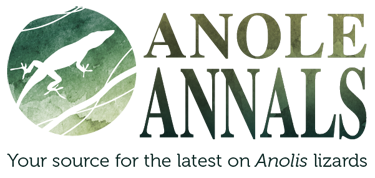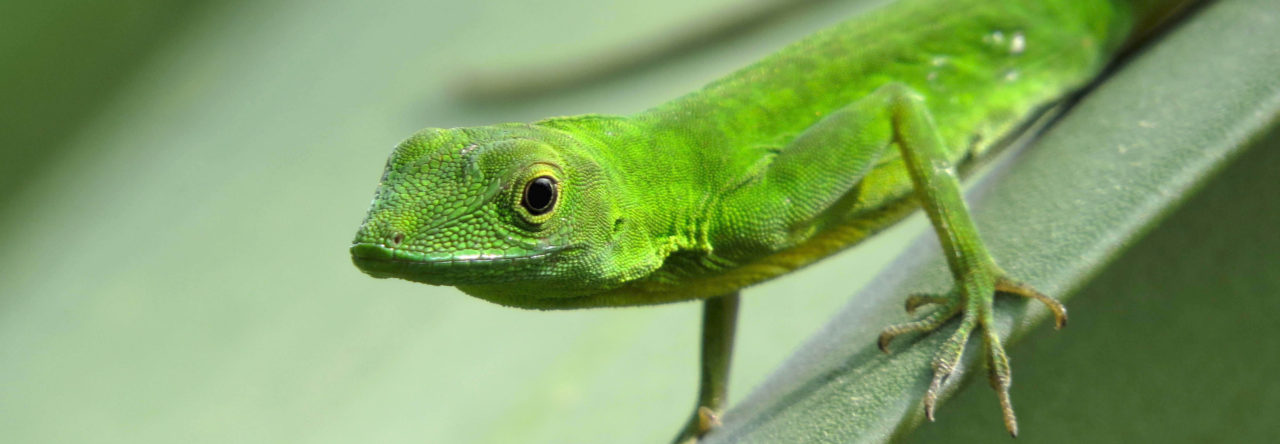The Caribbean’s history of tropical cyclones (e.g., hurricanes, tropical storms, tropical depressions) is well-known, and a number of studies have quantified how anole populations differ before and after a storm. Previous studies have recorded changes in anole phenotype, behavior, and population density following a tropical cyclone. That said, these are almost always opportunistic studies in which researchers collected data on anoles at a given site, a tropical cyclone impacted the area in which the data were collected, and then the researchers subsequently returned to the study site to collect the same type of data, this time post-storm. From these important studies, it is clear that tropical cyclones can have a near-immediate impact on anole populations, but what about over the long-term?

Tropical cyclones track passing within 500 km of Puerto Rico since 1955.
To understand if tropical cyclones have played a role in shaping the present-day distributions of anoles, we used random forests to individually model the distributions of all ten Puerto Rican anole species with and without data from the National Hurricane Center (NHC). Using the NHC data, we quantified variables related to tropical cyclone intensity (e.g., storm category, wind speed) and frequency (e.g., the number of tropical cyclones an individual anole experienced in a one-year window) to be used in species distribution models. Our results indicate that incorporating data on tropical cyclone intensity and frequency into species distribution models improves model predictive performance for nearly all ten Puerto Rican anole species. Additionally, the wind speed variable was identified as potentially important in shaping present-day species distribution patterns, particularly for A. cristatellus, A. krugi, A. pulchellus, and A. stratulus.

Linear regression of AUCtest with and without tropical cyclone variables for each of Puerto Rico’s anole species. AUCtest is a common metric used to assess species distribution models, with values closer to 1 indicative of more predictive models. The dashed red line follows y=x, where any values along that line indicate no change in model performance between models with and without tropical cyclone variables.
Although species distribution models can tell us which environmental variables are potentially important in shaping species distributions, they are limited in that they cannot tell us if there are underlying mechanisms shaping those spatial patterns. For example, hurricane wind speed is a potentially important variable in shaping anole distributions, but how? According to the wind speed response curve, it appears that anole habitat suitability (sometimes also referred to as “probability of presence”) decreases as wind speed increases… but why? I do not think anoles are getting ripped from the trees by powerful winds at a rate such that wind speeds are shaping anole distributions. Rather, it is more likely (and supported by other studies of how hurricanes impact wildlife) that tropical cyclones are shaping anole microhabitat and microclimate over long periods of time and thereby indirectly shaping anole distributions. More work is needed to understand how hurricanes shape anole distributions, but we believe this work is a step in the right direction.
You can read the full article here. If you don’t have access, please email me at anna.thonis@stonybrook.edu or anna.thonis8@gmail.com and I will happily send you a PDF copy.






 In Fall 2011, the International Union for the Conservation of Nature (IUCN) Species Survival Commission (SSC) Anoline Lizard Specialist Group (ALSG) was approved. The group had a good run for several years before entering a period of inactivity. At present, all IUCN activity pertaining to anoles goes through the
In Fall 2011, the International Union for the Conservation of Nature (IUCN) Species Survival Commission (SSC) Anoline Lizard Specialist Group (ALSG) was approved. The group had a good run for several years before entering a period of inactivity. At present, all IUCN activity pertaining to anoles goes through the 


